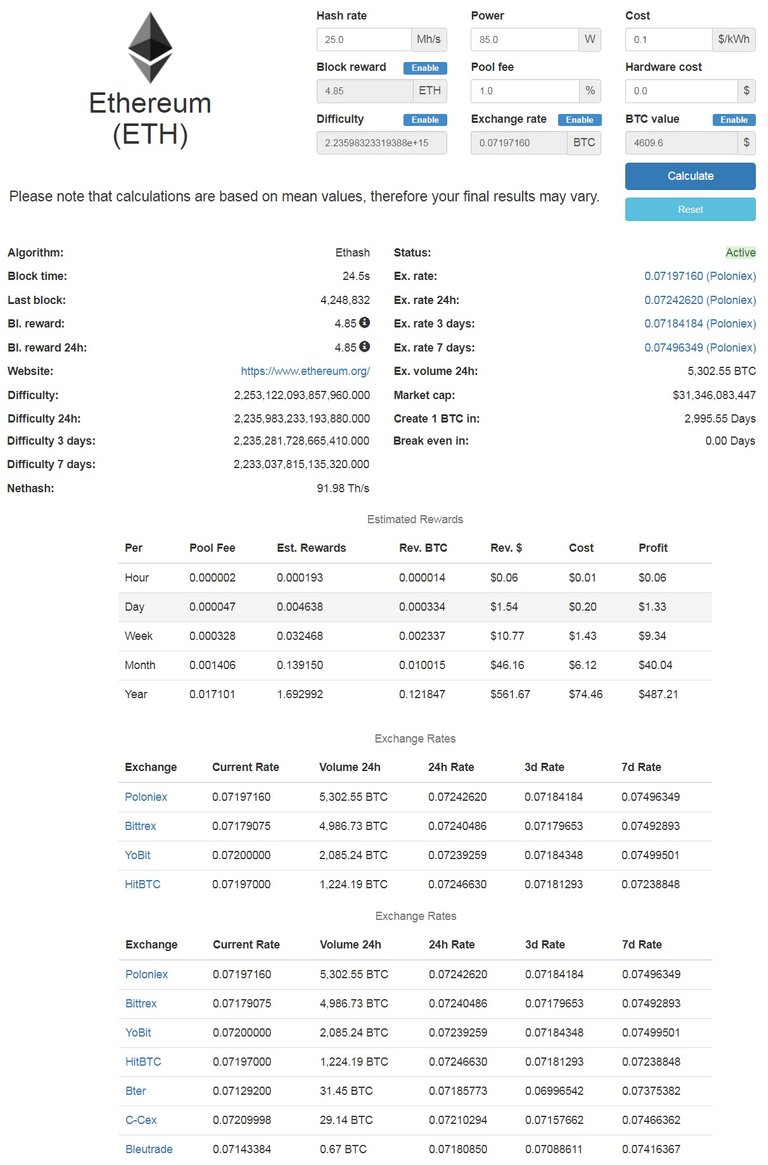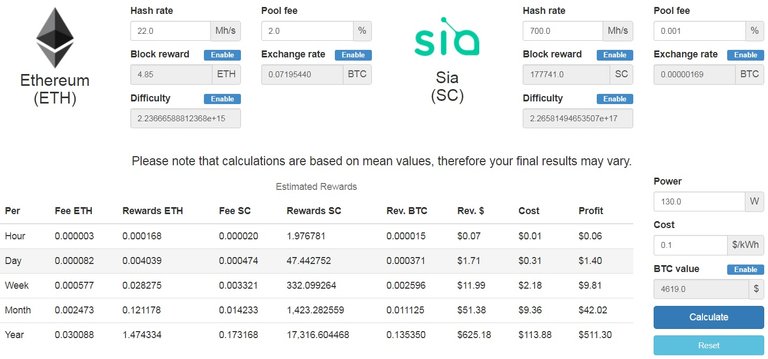Hello Steemers!
Let's start with the following question: what is Dual Mining?
Claymore's Dual Miner (considered one of the simplest and most effective miners) allows mining of one or more cryptones: Decred (DCR), Siacoin (SC), LBRY (LBC) or Pascal (PASC), in parallel to mining of Ethereum (ETH).
Following, we will try to perform an objective analysis of the dual mining mode, and we will see to what conclusions it leads us, trying to take the question independently of the power and type of hardware that each one of us has available, so that each one can do its own analysis.
If we start by evaluating the negative issues, we will quickly find the following:
1 - When dual mining mode is activated, we will divert part of the power of our hardware to the cryptocurrency mined in parallel, that is, we will be mining less Ethereum. A simple and frequent example happens if we do not have everything well configured in our rig, where we can go from 25MH/s to 22MH/s on each graphic card.
2- We will consume more energy, which in turn will generate more heat in the rig, and possibly more noise.
3- Activate dual mining, immediately increase the pool fee from 1% to 2%. This leads us to immediately lose 1% of our Ethereum mining capacity.
4- The over-demand of our hardware shortens the half-life of the same. This is real. However, the overloaded half-life will be longer than at the obsolete technology life. That is, you can’t break it before it becomes obsolete to mine.
Now let us begin to evaluate the positive issues, and we will quickly find the following:
1- If we configure our rig properly, the impact on the power of mining of Ethereum can be minimized.
Dual mining makes it possible to mine an extra cryptocurrency that could surprise us in the future, besides giving us some diversification (something very important for those who aim to add knowledge the potential market of other projects like SiaCoin).
Having mentioned the negative and positive issues, we can proceed to make an analysis in numbers of the question.
I will focus on my personal experience with SiaCoin for the rest of this post, in addition to being convinced that it is a project that is interesting to the future as the first cloud based on blockchain (you can know more about this project in the following link: http://sia.tech).
To do the analysis, I will take as reference the "WhatToMine?" web site, which can be accessed at the following link: https://whattomine.com/coins
As a first step, I will select Ethereum in the link section above, and I will upload the simplest data in the calculator imagining that I have a single graphics card: hash rate (25MH/s), power (85W), power cost U$D0.1/KW/h) and pool fee (1%). Then it is possible to incorporate more data to make the calculation more precise.
From this first step, I get the following:

This tells us that a single graphic card will be giving us U$D40.04 / month (for the day's quote, etc.).
Now, if we return to the previous link of the various cryptones, and select Ethereum in dual mining with SiaCoin, and place the following variables:
- Ethereum: hash rate (22MH/s), power (130W), power cost (U$D0.1/KW/h) and pool fee (2%).
- SiaCoin: hash rate (700MH/s), power (130W), power cost (U$D0.1/KW/h) and pool fee (0.001%).
From this second step, I obtain the following:

This tells us that a single video card in dual mining will be giving us U$D42.02/month (for the quotation of the day, etc.).
On the balance sheet, we see that we have a difference of U$D1.98/month (for the quotation of the day, etc.).
If we repeat the exercise for 6 graphic cards, we obtain the following:
- Ethereum Mining: U$D207.65/month.
- Ethereum + SiaCoin Dual Mining: U$D252.43/month.
- Balance: U$D44.73/month.
We can conclude that the dual mining allows us to give greater economic efficiency to our hardware, besides being able to add coin mined by CPU, an activity that also allows dual mining as the case of Monero working in parallel with FantomCoin.
So ... are you going to activate dual mining mode?
If you need help activating it, the tutorial post will be available to do it soon!
Thank you so much for reading until the end!
If you enjoyed this post, do not forget to leave your upvote, follow me and re-steem!
Great article - this is some really good information. I'm going to have to pass it on to my miner .. not sure if he is aware of this or not - but just started minim Monero recently , so maybe there is a way to be more efficient with it. What do you think about dual mining VS using two rigs and mining ETH on one and Monero on the other? Thanks
Hi @jorlauski! I think the most important is understand the hashing power from your rigs related to each cryptocurrency. First make a trial mining ETH, then Monero, etc. Then go to the mention at the post, and make the same comparison. Finally you will know how powerful is your system for each coin. After that, you can choose by hardware power and trust for each coin. I trust in ETH, for that reason I'm mining ETH in dual with SIA, and just use cpu for mining Monero in dual with FantomCoin. I hope this can help! Regards
Congratulations @fabioborgogno! You received a personal award!
You can view your badges on your Steem Board and compare to others on the Steem Ranking
Vote for @Steemitboard as a witness to get one more award and increased upvotes!
Congratulations @fabioborgogno! You received a personal award!
You can view your badges on your Steem Board and compare to others on the Steem Ranking
Do not miss the last post from @steemitboard:
Vote for @Steemitboard as a witness to get one more award and increased upvotes!